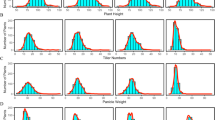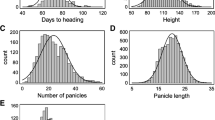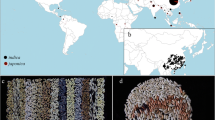Abstract
Awn is one of the most important domesticated traits in rice (Oryza sativa). Understanding the genetic basis of awn length is important for grain harvest and production, because long awn length is disadvantageous for both grain harvest and milling. We investigated the awn length of 529 rice cultivars and performed a Genomewide association studies (GWAS) in the indica and japonica subpopulations, and the whole population. In total, we found 17 loci associated with awn length. Of these loci, seven were linked to previously reported quantitative trait loci, and one was linked to the awn gene An-1. Nine novel loci were repeatedly identified in different environments. One of the nine associations was identified in both the whole and japonica populations. Special interest was the detection of the most significant association SNP, sf0136352825, which was less than 95 kb from the seed shattering gene qSH1. These results may provide potentially favourable haplotypes for molecular breeding in rice.



Similar content being viewed by others
References
Cai H. W. and Morishima H. 2002 QTL clusters reflect character associations in wild and cultivated rice. Theor. Appl. Genet. 104, 1217–1228.
Chen W., Gao Y. Q., Xie W. B., Gong L., Lu K., Wang W. S. et al. 2014 Genome-wide association analyses provide genetic and biochemical insights into natural variation in rice metabolism. Nat. Genet. 46, 714–721.
Cheng C. Y., Motohashi R., Tsuchimoto S., Fckuta Y., Ohtsubo H. and Ohtsubo E. 2003 Polyphyletic origin of cultivated rice: based on the interspersion pattern of SINEs. Mol. Biol. Evol. 20, 67–75.
Elbaum R., Zaltzman L., Burgert I. and Fratzl P. 2007 The role of wheat awns in the seed dispersal unit. Science 316, 884–886.
Gu X. Y., Kianian S. F. and Foley M. E. 2005a Phenotypic selection for dormancy introduced a set of adaptive haplotypes from weedy into cultivated rice. Genetics 171, 695–704.
Gu X. Y., Kianian S. F., Hareland G. A., Hoffer B. L. and Foley M. E. 2005b Genetic analysis of adaptive syndromes interrelated with seed dormancy in weedy rice (Oryza sativa). Theor. Appl. Genet. 110, 1108–1118.
Hua L., Wang D. R., Tan L. B., Fu Y. C., Liu F. X., Xiao L. T. et al. 2015 LABA1, a domestication gene associated with long, barbed awns in wild rice. Plant Cell 27, 1875–1888.
Huang X. H., Zhao Y., Wei X. H., Li C. Y., Wang A. H., Zhao Q. et al. 2011 Genome-wide association study of flowering time and grain yield traits in a worldwide collection of rice germplasm. Nat. Genet. 44, 32–39.
Huang X. H., Kurata N., Wei X. H., Wang Z. -X., Wang A. H., Zhao Q. et al. 2012 A map of rice genome variation reveals the origin of cultivated rice. Nature 490, 497–501.
Izawa T., Konishi S., Shomura A. and Yano M. 2009 DNA changes tell us about rice domestication. Curr. Opin. Plant. Biol. 12, 185–192.
Konishi S., Izawa T., Lin S. Y., Ebana K., Fukuta Y., Sasaki T. et al. 2006 An SNP caused loss of seed shattering during rice domestication. Science 312, 1392–1396.
Li C. B., Zhou A. L. and Sang T. 2006 Rice domestication by reducing shattering. Science 311, 1936–1939.
Li M. X., Yeung J. M., Cherny S. S. and Sham P. C. 2012 Evaluating the effective numbers of independent tests and significant p-value thresholds in commercial genotyping arrays and public imputation reference datasets. Hum. Genet. 131, 747–756.
Librado P. and Rozas J. 2009 DnaSP v5: a software for comprehensive analysis of DNA polymorphism data. Bioinformatics 25, 1451–1452.
Lippert C., Listgarten J., Liu Y., Kadie C. M., Davidson R. I. and Heckerman D. 2011 FaST linear mixed models for genome-wide association studies. Nat. Methods 8, 833–835.
Luo J. H., Liu H., Zhou T. Y., Gu B. G., Huang X. H., Shangguan Y. Y. et al. 2013 An-1 encodes a basic helix-loop-helix protein that regulates awn development, grain size, and grain number in rice. Plant Cell 25, 3360–3376.
Mather K. A., Caicedo A. L., Polato N. R., Olsen K. M., McCouch S. and Purugganan M. D. 2007 The extent of linkage disequilibrium in rice (Oryza sativa L.). Genetics 177, 2223–2232.
McNally K. L., Childs K. L., Bohnert R., Davidson R. M., Zhao K., Ulat V. J. et al. 2009 Genome wide SNP variation reveals relationships among landraces and modern varieties of rice. Proc. Natl. Acad. Sci. USA 106, 12273–12278.
Oka H. I. (Ed.) 1988 Origin of cultivated rice. Japan Scientific Societies Press, Tokyo, Japan.
Second G. 1982 Origin of the genic diversity of cultivated rice (Oryza spp.): study of the polymorphism scored at 40 isozyme loci. Jpn. J. Genet. 57, 25–57.
Tanaka W., Toriba T., Ohmori Y., Yoshida A., Kawai A., Mayama-Tsuchida T. et al. 2012 The YABBY gene TONGARI-BOUSHI1 is involved in lateral organ development and maintenance of meristem organization in the rice spikelet. Plant Cell 24, 80–95.
Thomson M. J., Tai T. H., McClung A. M., Lai X. -H., Hinga M. E., Lobos K. B. et al. 2003 Mapping quantitative trait loci for yield, yield components and morphological traits in an advanced backcross population between Oryza rufipogon and the Oryza sativa cultivar Jefferson. Theor. Appl. Genet. 107, 479–493.
Toriba T. and Hirano H. -Y. 2014 The DROOPING LEAF and OsETTIN2 genes promote awn development in rice. Plant J. 77, 616–626.
Wang L., Wang A. H., Huang X. H., Zhao Q., Dong G. J., Qian Q. et al. 2011 Mapping 49 quantitative trait loci at high resolution through sequencing-based genotyping of rice recombinant inbred lines. Theor. Appl. Genet. 122, 327–340.
Wang Q. X., Xie W. B., Xing H. K., Yan J., Meng X. Z., Li X. L. et al. 2015 Genetic architecture of natural variation in rice chlorophyll content revealed by genome wide association study. Mol. Plant 8, 946–957.
Yang W. N., Guo Z. L., Huang C. L., Duan L. F., Chen G. X., Jiang N. et al. 2014 Combining high-throughput phenotyping and genome-wide association studies to reveal natural genetic variation in rice. Nat. Commun. 5, 5087.
Yu J. M., Pressoir G., Briggs W. H., Bi I. V., Yamasaki M., Doebley J. F. et al. 2006 A unified mixed-model method for association mapping that accounts for multiple levels of relatedness. Nat. Genet. 38, 203–208.
Zhang Z. W., Ersoz E., Lai C. -Q., Todhunter R. J., Tiwari H. K., Gore M. A. et al. 2010 Mixed linear model approach adapted for genome-wide association studies. Nat. Genet. 42, 355–360.
Zhao K. Y., Tung C. W., Eizenga G. C., Wright M. H., Ali M. L., Price A. H. et al. 2011 Genome-wide association mapping reveals a rich genetic architecture of complex traits in Oryza sativa. Nat. Commun. 2, 467.
Zong Y., Chen Z., Innes J. B., Chen C., Wang Z. and Wang H. 2007 Fire and flood management of coastal swamp enabled first rice paddy cultivation in east China. Nature 449, 459–462.
Acknowledgements
This work was supported by grants from the National Science Foundation of China (31300991, 91335201), the National Special Programme for Research of Transgenic Plants of China (2014ZX0800936B) and the 863 programme on the functional genomics of stress resistance and nutrient utility in rice (2012 AA10A303).
Author information
Authors and Affiliations
Corresponding author
Additional information
Magwa R. A., Zhao H., Yao W., Xie W., Yang L., Xing Y. and Bai X. 2016 Genomewide association analysis for awn length linked to the seed shattering gene qSH1 in rice. J. Genet. 95, xx–xx
Rights and permissions
About this article
Cite this article
MAGWA, R.A., ZHAO, H., YAO, W. et al. Genomewide association analysis for awn length linked to the seed shattering gene qSH1 in rice. J Genet 95, 639–646 (2016). https://doi.org/10.1007/s12041-016-0679-1
Received:
Revised:
Accepted:
Published:
Issue Date:
DOI: https://doi.org/10.1007/s12041-016-0679-1




